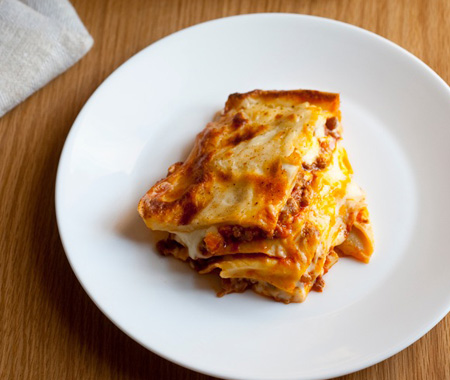Recipe
January 2, 2012
Lasagna Bolognese Recipe

Step 1: Heat the olive oil in a pan, add the carrot and onion, and cook over low heat, stirring occasionally, for 5 minutes.
Step 2: Add the meat and cook until browned, then pour in the wine and cook until it has evaporated. Season with salt, add the tomatoes, and simmer for 30 minutes, then season with pepper.
Step 3: Preheat the oven to 400°F. Grease an ovenproof dish with butter.
Step 4: Roll out the pasta dough (see below) into a sheet. Cut into 4″ squares and cook, a few at a time, in plenty of lightly salted, boiling water for a few minutes. Drain and place on a damp dish towel.
Step 5: Arrange a layer of lasagna on the bottom of the prepared dish, spoon over some of the meat sauce, then some of the béchamel sauce (see below) on top, sprinkle with some of the Parmesan, and dot with some of butter. Repeat the alternating layers until all the ingredients have been used, ending with a layer of béchamel sauce. Bake for 30 minutes.
Fresh Pasta Dough
Step 1: Sift the flour into a mound on the counter. Make an 8″ well in the centre. Beat the eggs and the yolk together, then place in the well. Using your fingers in a stirring motion, gradually incorporate the flour, the knead for about 10 minutes, or until the dough is smooth and satiny. If the mixture is too soft, add a little extra flour; if it is too firm, add a little water by running some water over your hands, then kneading the dough with wet hands. Shape the dough into a ball and let rest for at least 1 hour. The dough can be made 24 hours in advance and kept wrapped in plastic wrap in the refrigerator.
Step 2: Roll out on a lightly floured counter or use a pasta machine to make thin sheets by passing the dough through the rollers starting with the widest width. Pass the dough 3-4 times through the two widest settings, folding the dough in half lengthwise between each roll. Continue to roll the sheets more thinly. Hang the thin sheets of pasta to dry. When the pasta sheets feel leathery and no longer stick to themselves when pressed together, they are ready to be cut into tagliatelle or lasagne. If they’re dried for too long, the pasta will crack. It is best to cook the pasta immediately after drying and cutting by immersing in a large pot of boiling salted water. If you are not going to eat the pasta right away, blanch the pasta by immersing it in the boiling water for 30 seconds. Drain, rinse in cold water, an drain again then toss in a little olive oil. Store in a plastic bag in the refrigerator or freeze.
Step 3: To cook, immerse in boiling salted water. Note that fresh pasta takes only a minute or two to cook until al dente, which means that it will still have a little “bite” or texture to it.
Béchamel Sauce
Step 1: Melt the butter in a pan over medium heat. Remove the pan from the heat and whisk in the flour to make a smooth paste. Using a wooden spoon, gradually stir in all the milk, making sure the sauce is smooth between each addition. Return the pan to the heat and cook over medium-high heat, stirring continuously until it starts to boil. Season with salt, lower the heat, cover, and simmer gently over low heat, stirring occasionally, for at least 20 minutes.
Step 2: The sauce should be thick enough to coat the back of the spoon and not run off. Remove the pan from the heat. Taste, add more salt, if necessary, and season, with pepper and/or nutmeg. Béchamel sauce should not taste floury. If the sauce is too thick, add a little more milk. If too runny, boil for a little longer. Making this delicious sauce, considered a basic sauce due to its versatility and usefulness, is an essential cooking skill. For a richer béchamel sauce, replace half the milk with the same amount of heavy cream; for a lighter béchamel sauce, add half milk and half water. Use for gratins, soufflés, or stuffings.
See more recipes from The Silver Spoon.
Reprinted with permission from The Silver Spoon, $59.95 (2011 Phaidon).
Directions
Yield:
Step 1: Heat the olive oil in a pan, add the carrot and onion, and cook over low heat, stirring occasionally, for 5 minutes.
Step 2: Add the meat and cook until browned, then pour in the wine and cook until it has evaporated. Season with salt, add the tomatoes, and simmer for 30 minutes, then season with pepper.
Step 3: Preheat the oven to 400°F. Grease an ovenproof dish with butter.
Step 4: Roll out the pasta dough (see below) into a sheet. Cut into 4″ squares and cook, a few at a time, in plenty of lightly salted, boiling water for a few minutes. Drain and place on a damp dish towel.
Step 5: Arrange a layer of lasagna on the bottom of the prepared dish, spoon over some of the meat sauce, then some of the béchamel sauce (see below) on top, sprinkle with some of the Parmesan, and dot with some of butter. Repeat the alternating layers until all the ingredients have been used, ending with a layer of béchamel sauce. Bake for 30 minutes.
Fresh Pasta Dough
Step 1: Sift the flour into a mound on the counter. Make an 8″ well in the centre. Beat the eggs and the yolk together, then place in the well. Using your fingers in a stirring motion, gradually incorporate the flour, the knead for about 10 minutes, or until the dough is smooth and satiny. If the mixture is too soft, add a little extra flour; if it is too firm, add a little water by running some water over your hands, then kneading the dough with wet hands. Shape the dough into a ball and let rest for at least 1 hour. The dough can be made 24 hours in advance and kept wrapped in plastic wrap in the refrigerator.
Step 2: Roll out on a lightly floured counter or use a pasta machine to make thin sheets by passing the dough through the rollers starting with the widest width. Pass the dough 3-4 times through the two widest settings, folding the dough in half lengthwise between each roll. Continue to roll the sheets more thinly. Hang the thin sheets of pasta to dry. When the pasta sheets feel leathery and no longer stick to themselves when pressed together, they are ready to be cut into tagliatelle or lasagne. If they’re dried for too long, the pasta will crack. It is best to cook the pasta immediately after drying and cutting by immersing in a large pot of boiling salted water. If you are not going to eat the pasta right away, blanch the pasta by immersing it in the boiling water for 30 seconds. Drain, rinse in cold water, an drain again then toss in a little olive oil. Store in a plastic bag in the refrigerator or freeze.
Step 3: To cook, immerse in boiling salted water. Note that fresh pasta takes only a minute or two to cook until al dente, which means that it will still have a little “bite” or texture to it.
Béchamel Sauce
Step 1: Melt the butter in a pan over medium heat. Remove the pan from the heat and whisk in the flour to make a smooth paste. Using a wooden spoon, gradually stir in all the milk, making sure the sauce is smooth between each addition. Return the pan to the heat and cook over medium-high heat, stirring continuously until it starts to boil. Season with salt, lower the heat, cover, and simmer gently over low heat, stirring occasionally, for at least 20 minutes.
Step 2: The sauce should be thick enough to coat the back of the spoon and not run off. Remove the pan from the heat. Taste, add more salt, if necessary, and season, with pepper and/or nutmeg. Béchamel sauce should not taste floury. If the sauce is too thick, add a little more milk. If too runny, boil for a little longer. Making this delicious sauce, considered a basic sauce due to its versatility and usefulness, is an essential cooking skill. For a richer béchamel sauce, replace half the milk with the same amount of heavy cream; for a lighter béchamel sauce, add half milk and half water. Use for gratins, soufflés, or stuffings.
See more recipes from The Silver Spoon.
Reprinted with permission from The Silver Spoon, $59.95 (2011 Phaidon).
[img_assist|nid=2090391|title=|desc=|link=popup|align=middle|width=225|height=339]Edward Park

